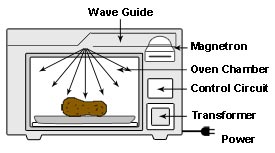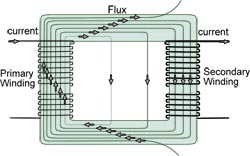Microwave Radio Frequencies
Microwave radio frequencies are electromagnetic waves with wavelength with the sizes ranging between 1mm - 1m. The frequency utilized are in the 0.3 GH and 300 GHz range. Microwave ovens are basically accelerated radio wave machines that contain a concentrated radio frequency inside a chamber. Microwave frequencies have adverse effects on humans. This is why the government employs the "Active Denial System" Energy Weapon for crowd control. More importantly, microwave frequencies cause heat in water.
Coinciding history of Satellites and Microwave Radio Frequencies.
Wireless computer networks, cellular phones, and satellite dish networks, and the use of microwave frequencies have become a household thing. The following is a brief timeline of Microwave Frequency communications from satellites. Global Warming history from PBS.
1950/57
- USA began widely Broadcasting UHF and VHF.
- First man-made Earth satellite launched by the former Soviet Union.
1958
- First US satellite launched. First voice communication established via satellite.
1960
- First communication satellite (passive) launched into space.
1962
- First active communication satellite launched.
1964
- Japan and the UK begins UHF and has already established VHF broadcasting.
- First satellite launched into the geostationary orbit. INTELSAT founded.
1965
- Roger Revelle helped publish the first high-level government mention of global warming.
- First satellite launched into the geostationary orbit for commercial use.
1970/75
- Canada Broadcasts UHF and VHF
- First domestic satellite system operational (Canada). INTERSPUTNIK founded (1972)
- First successful direct broadcast experiment (one year duration; USA-India).
1977/79
- The National Academy of Sciences issued a study called Energy and Climate (1977)
- UHF Broadcasting in Ireland
- International mobile satellite organization (Inmarsat) established
1980/81
- Representative Al Gore co-sponsored the first Congressional hearings to study the implications of global warming.
- UHF Broadcasting in Australia.
- First reusable launch vehicle flight. (American Space Shuttle)
1982
- Roger Revelle published a widely-read article in SCIENTIFIC AMERICAN addressing the rise in global sea level by the melting of glaciers.
- International maritime communications made operational
1984
- First direct-to-home broadcast system operational (Japan)
1987/88
- Successful trials of land mobile communications ( Inmarsat)
- NASA climate scientist James Hansen and his team reported to Congress on global warming. (1988)
- the Intergovernmental Panel on Climate Change (IPCC) was established. (1988)
1989/90
- Global mobile communication service extended to land mobile and aeronautical use (Inmarsat)
1990/93
- the Global Change Research Information Office (GCRIO) was established.
- Congress passed and President George Bush signed Public Law 101-606 "The Global Change Research Act of 1990."
- Several organizations/companies propose the use of non-geostationary satellite system for mobile communications.
- the U.N. Conference on Environment and Development. (UNCED or the "Earth Summit")
- Plans for provision of service to hand-held telephones by the year 2000 announced by several organizations/companies.
- Continuing growth of VSATs in diverse regions of the world.WRC allocates new frequencies for mobile satellite communication.
- Continuing growth of direct broadcast in Asia and Europe.
1995
- Largest single-year worldwide growth in the numbers of VSATs.
- Spectrum allocation for non-geostationary satellite system.
- First successful test of low data rate commercial low Earth orbit satellite system (ORBCOM).
1997
- Launch of first batch of low earth orbit satellites for provision of voice services to hand-held terminals (Iridium).
- Voice communication services to desk-top telephone sized mobile terminal launched (Inmarsat).
- Paging service to pocket-siged terminals launched (Inmarsat).
- Kyoto Protocol, in which the developed nations agreed to limit their greenhouse gas emissions, relative to the levels emitted in 1990.
1998
- Introduction of hand-held services via low Earth orbit constellation.
1990/00
- Introduction of direct sound broadcasting system.
2001
- The IPCC released its third assessment report, concluding on the basis of "new and stronger evidence that most of the observed warming over the last 50 years is attributable to human activities." They also observed that "the globally averaged surface temperature is projected to increase by 1.4 to 5.8 degrees Celsius over the period 1990 to 2100."
2004
- The Bush Administration came into conflict with the world community when it appeared to take issue with parts of an eight-nation report compiled by 250 scientists which contended that the Arctic is warming almost twice as fast as the rest of the planet due to a buildup of heat-trapping gases.
2000/05
- FCC awards 90 MHz of additional spectrum for advanced wireless services.
- Delivery of digital wireless data and voice enhanced networks (2.5G) On October 13, 2003
- 20th Anniversary of Commercial Wireless Communications.
- Introduction of broadband personal communications.
- Orbital Debris becomes an issue.
- Ka band system proliferate.
- A number of low and medium orbit constellation system operational.
- The Kyoto Protocol entered into force on February 16, 2005. Industrialized countries have committed to cut their combined emissions to 5% below 1990 levels by 2008 - 2012.
TOP
Radio Frequencies
In the table below you will see how microwave frequencies are used and what their frequencies are.
| Band name |
Abbr |
band |
Frequency
and
Wavelength |
Example uses |
| Extremely low frequency |
ELF |
1 |
3–30 Hz
100,000 km – 10,000 km |
Communication with submarines |
| Super low frequency |
SLF |
2 |
30–300 Hz
10,000 km – 1000 km |
Communication with submarines |
| Ultra low frequency |
ULF |
3 |
300–3000 Hz
1000 km – 100 km |
Communication within underground mines |
| Very low frequency |
VLF |
4 |
3–30 kHz
100 km – 10 km |
Submarine communication, avalanche beacons, wireless heart rate monitors, and geophysics |
| Low frequency |
LF |
5 |
30–300 kHz
10 km – 1 km |
Navigation, Time signals, AM Radio |
| Medium frequency |
MF |
6 |
300–3000 kHz
1 km – 100 m |
AM Radio |
| High frequency |
HF |
7 |
3–30 MHz
100 m – 10 m |
Shortwave Radio and aviation communications |
| Very high frequency |
VHF |
8 |
30–300 MHz
10 m – 1 m |
FM Radio, TV broadcasts, and aircraft communications |
| Ultra high frequency |
UHF |
9 |
300–3000 MHz
1 m – 100 mm |
TV broadcasts, microwave ovens, mobile phones, wireless LAN, Bluetooth, GPS, and Two-Way Radios |
| Super high frequency |
SHF |
10 |
3–30 GHz
100 mm – 10 mm |
Radars, Mobile Phones, and Commercial Wireless LAN |
| Extremely high frequency |
EHF |
11 |
30–300 GHz
10 mm – 1 mm |
High-speed satellite microwave transmission |
| Source from Wikipedia Radio Frequency |
TOP
How a Microwave Oven works?

This is a drawing of how a microwave oven works.
In order to understand how microwaves work in general, it is necessary to understand how radio frequencies cause heating. The parts of a microwave that create the radio frequencies are the transformer, cavity magnetron, micro controller, and wave guide. Click here for a great explanation of Radio Frequency Heating. Microwave ovens work by passing non ionizing microwave radiation through the food, at a frequency approximately 2.5 GHz. Microwave ovens produce waves similar to that of a typical wireless phone. Microwave radio frequencies pass through water, fat, and other substances causing a process called dielectric heating. Water molecules have a positive charge at one end and a negative charge at the other called electric dipoles. As microwaves pass through water molecules, the molecules rotate as they try to align themselves with the alternating electric field. This molecular movement creates heat. Microwave heating is most effective on liquid water.

This is an image of molecular friction due to RF heating from the
Colorado EDUThe image to the left is an illustration from the Colorado EDU. This illustration shows how molecules rotate and cause friction between each other when microwave radio frequencies passed through. One may ask themselves, "Do microwave ovens have any hazards?" In fact microwave ovens can leak microwave frequencies outside of the oven. Some say that the newer microwaves today have no health risks due to better constructed units. (See the Canadian Center for Health and Safety) Exposure to higher wattage can affect a humans health. But what about lower wattages. Lower wattages can cause things to cook as well, the only difference is that it takes longer. Factors like, concentration of the waves, power wattage, and frequency levels are what determine how fast something will cook or melt.
TOP
Microwave Oven Components
A microwave oven consists of:
- a high voltage transformer, which passes energy to the magnetron
- a cavity magnetron,
- a magnetron control circuit (usually with a microcontroller),
- a waveguide, and
- a cooking chamber

Magnetron with section removed (magnet is not shown) picture taken by
HCRS
Understanding how a microwave works can be achieved by studying the parts and how they work. First we will take a close look at the specifications a waveguide. The waveguide is an essential function of the microwave oven.
A Waveguide is any linear structure that guides electromagnetic waves for the purpose of transmitting power or signals. Generally constructed of a hollow metal pipe. Placing a waveguide into a vacuum causes radio waves to scatter.
A Cavity magnetron is a microwave antenna placed in a vacuum tube and oscillated in an electromagnetic field in order to produce high GHz microwaves. Magnetrons are in microwave ovens and radar systems.

This is a picture of a micro controller.
A Microcontroller is a microprocessor that is integrated on a circuit board. Like in cell phones and satellite dishes. Here is a SIS chip on a graphics card. This is what an integrated processor looks like. The microcontroller controls the waveguide and the entire unit so the microwaves are emitted at a constant rate.

This is how a transformer works.
A Transformer is two or more coupled windings and a magnetic flux core that transfers electrical energy through a circuit by magnetic coupling without using motion between parts. These are used for supplying power to the magnetron.
A Cooking Chamber is a microwave safe container the prevents microwaves from escaping. The door has a microwave proof mesh with holes that are just small enough that microwaves can't pass through but lightwaves can. The cooking chamber itself is a Faraday cage enclosure which prevents the microwaves from escaping into the environment. The oven door is usually a glass panel for easy viewing, but has a layer of conductive mesh to maintain the shielding. Because the size of the perforations in the mesh is much less than the wavelength of 12 cm, most of the microwave radiation cannot pass through the door, while visible light (with a much shorter wavelength) can.
TOP






